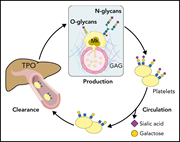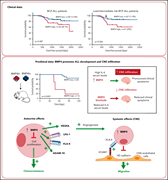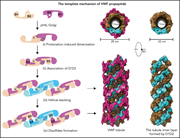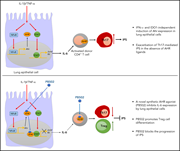Issue Archive
Table of Contents
EDITORIAL
Introduction to a review series on megakaryopoiesis and platelet production
Hematologists have long been fascinated by how platelet production occurs, and our understanding continues to evolve as technology advances and as more and more genetic causes for thrombocytopenia are discovered. In this Review Series on megakaryopoiesis and platelet production edited by Associate Editor John Crispino, experts in the field discuss the latest insights into megakaryopoiesis in fetal and adult life, the varied roles that megakaryocytes are now recognized to play, the mechanics of platelet creation, and how all of this new knowledge underpins clinical disorders requiring diagnosis and management.
BLOOD COMMENTARIES
REVIEW SERIES
Fetal vs adult megakaryopoiesis
Hematologists have long been fascinated by how platelet production occurs, and our understanding continues to evolve as technology advances and as more and more genetic causes for thrombocytopenia are discovered. In this Review Series on megakaryopoiesis and platelet production edited by Associate Editor John Crispino, experts in the field discuss the latest insights into megakaryopoiesis in fetal and adult life, the varied roles that megakaryocytes are now recognized to play, the mechanics of platelet creation, and how all of this new knowledge underpins clinical disorders requiring diagnosis and management.
Don’t you forget about me(gakaryocytes)
Hematologists have long been fascinated by how platelet production occurs, and our understanding continues to evolve as technology advances and as more and more genetic causes for thrombocytopenia are discovered. In this Review Series on megakaryopoiesis and platelet production edited by Associate Editor John Crispino, experts in the field discuss the latest insights into megakaryopoiesis in fetal and adult life, the varied roles that megakaryocytes are now recognized to play, the mechanics of platelet creation, and how all of this new knowledge underpins clinical disorders requiring diagnosis and management.
Clinical impact of glycans in platelet and megakaryocyte biology
Hematologists have long been fascinated by how platelet production occurs, and our understanding continues to evolve as technology advances and as more and more genetic causes for thrombocytopenia are discovered. In this Review Series on megakaryopoiesis and platelet production edited by Associate Editor John Crispino, experts in the field discuss the latest insights into megakaryopoiesis in fetal and adult life, the varied roles that megakaryocytes are now recognized to play, the mechanics of platelet creation, and how all of this new knowledge underpins clinical disorders requiring diagnosis and management.
Genetics of inherited thrombocytopenias
Hematologists have long been fascinated by how platelet production occurs, and our understanding continues to evolve as technology advances and as more and more genetic causes for thrombocytopenia are discovered. In this Review Series on megakaryopoiesis and platelet production edited by Associate Editor John Crispino, experts in the field discuss the latest insights into megakaryopoiesis in fetal and adult life, the varied roles that megakaryocytes are now recognized to play, the mechanics of platelet creation, and how all of this new knowledge underpins clinical disorders requiring diagnosis and management.
CLINICAL TRIALS AND OBSERVATIONS
Fixed-duration ibrutinib plus venetoclax for first-line treatment of CLL: primary analysis of the CAPTIVATE FD cohort
Clinical Trials & Observations
Ibrutinib and venetoclax are 2 first-in-class novel, non-DNA-damaging anticancer drugs that have each changed outcomes for patients with chronic lymphocytic leukemia (CLL). Tam and colleagues report on a large multicenter phase 2 trial of a fixed duration (15 cycles) of the 2 drugs in combination for previously untreated patients. While longer follow up and phase 3 trials are needed, the 55% complete remission rate, high rates of negativity for minimal residual disease, acceptable safety profile, and few relapses or deaths after 2 years indicate strong promise for this once-daily oral regimen.
IMMUNOBIOLOGY AND IMMUNOTHERAPY
Targeting macrophages for enhancing CD47 blockade–elicited lymphoma clearance and overcoming tumor-induced immunosuppression
The therapeutic potential of monoclonal antibodies to block “don’t eat me” signaling by malignant cells in the tumor microenvironment is rapidly emerging. Cao and colleagues report on a novel and clinically amenable way to prime phagocytes in vivo to enhance the anticancer effect of macrophage checkpoint inhibition. Through direct effects on macrophages, subtoxic doses of paclitaxel synergise potently with anti-CD47 therapy to clear resistant lymphomas in murine models.
LYMPHOID NEOPLASIA
High BMP4 expression in low/intermediate risk BCP-ALL identifies children with poor outcomes
Central nervous system (CNS) relapse is a contributor to poor outcomes in patients with B-cell precursor acute lymphoblastic leukemia (BCP-ALL). Fernández-Sevilla et al provide clinical and experimental evidence that BMP4 expression levels in leukemia cells could be a useful biomarker to identify children with poor outcome in the low/intermediate risk groups of BCP-ALL. The authors further show in preclinical models that targeting BMP4 has therapeutic potential to prevent or treat leukemic CNS disease.
THROMBOSIS AND HEMOSTASIS
Structural basis of von Willebrand factor multimerization and tubular storage
The release of von Willebrand factor (VWF) into the blood controls platelet adhesion and aggregation. Zeng and colleagues used cryo-electron microscopy to reveal how VWF tubule formation is initiated by a pH-sensing homodimer of the propeptide in a multistep process. From this procedure, they showed how clinical Type 2A von Willebrand disease mutations disrupt this process, leading to diminished VWF multimers in plasma, and how these defects could potentially be rectified.
TRANSPLANTATION
Aryl hydrocarbon receptor–targeted therapy for CD4+ T cell–mediated idiopathic pneumonia syndrome in mice
Idiopathic pneumonia syndrome (IPS) remains a serious complication after allogeneic hematopoietic stem cell transplant (HSCT), causing respiratory failure and death. Lee et al identified aryl hydrocarbon receptor (AHR) to be a critical inflammation checkpoint in lung epithelium, mediating suppression of cytokine-induced activator protein-1 family gene expression. In an in vivo model of IPS after HSCT, the authors demonstrated that pharmacological stimulation of AHR reduces IPS, suggesting a strategy for future clinical exploration.
LETTER TO BLOOD
Secondary resistance to idelalisib is characterized by upregulation of IGF1R rather than by MAPK/ERK pathway mutations
BLOOD WORK
ERRATA
-
Cover Image
Cover Image
![issue cover]()
A megakaryocyte in the bone marrow. This ultrathin section of murine bone marrow seen by transmission electron microscopy demonstrates a megakaryocyte positioned close to a sinusoid, poised to release proplatelets into the bloodstream. The image was acquired using a Jeol 1200EX electron microscope at a magnification of ×890. See the article by Tilburg et al on page 3245.
- PDF Icon Front MatterFront Matter
- PDF Icon Table of ContentsTable of Contents
- PDF Icon Back MatterBack Matter
- PDF Icon Editorial BoardEditorial Board
Advertisement intended for health care professionals
Email alerts
Advertisement intended for health care professionals












A CAPTIVATE-ing new regimen for CLL
Clinical Trials & Observations